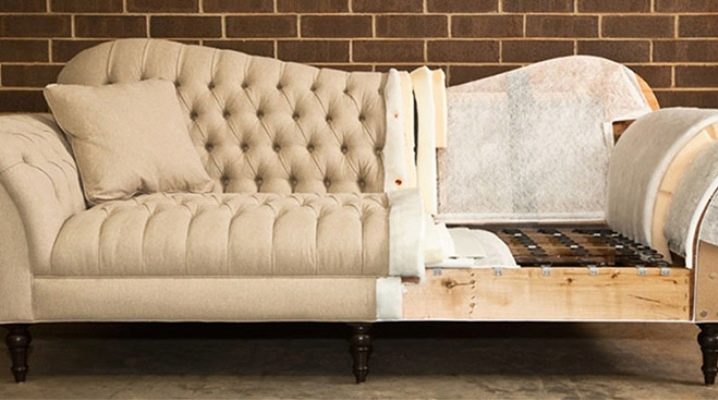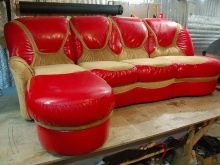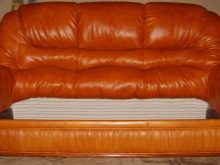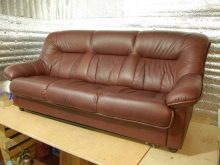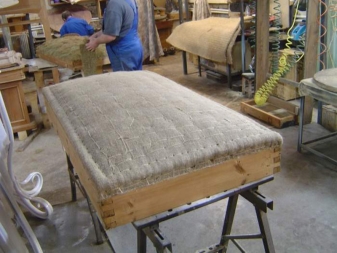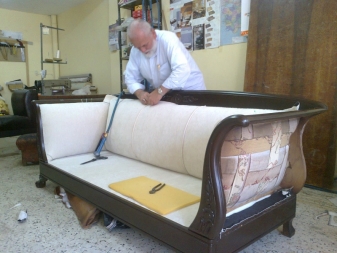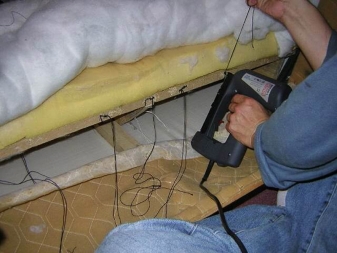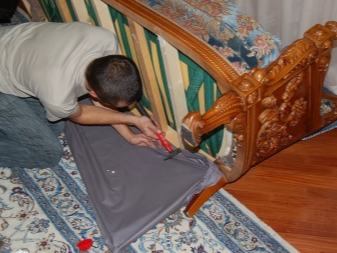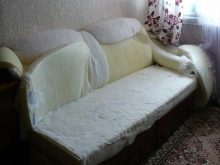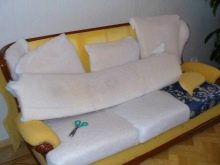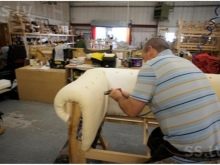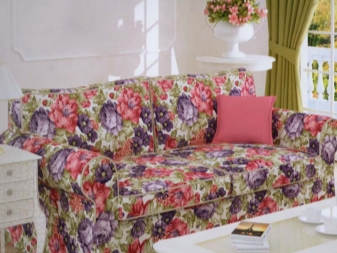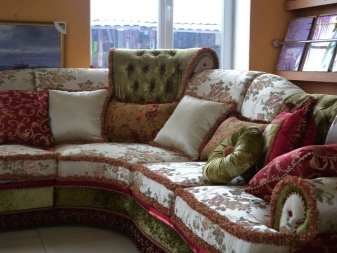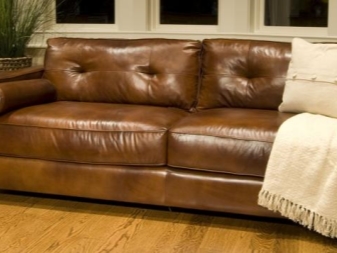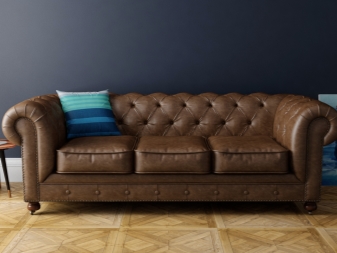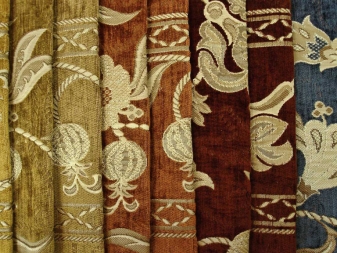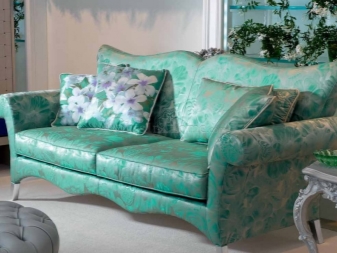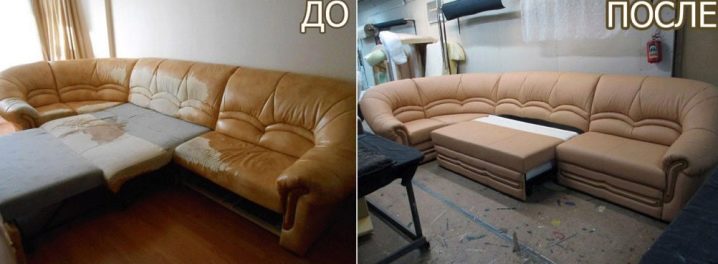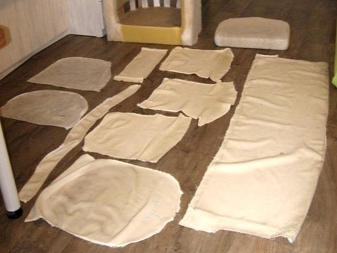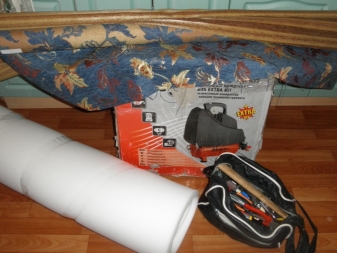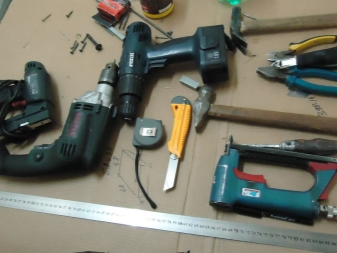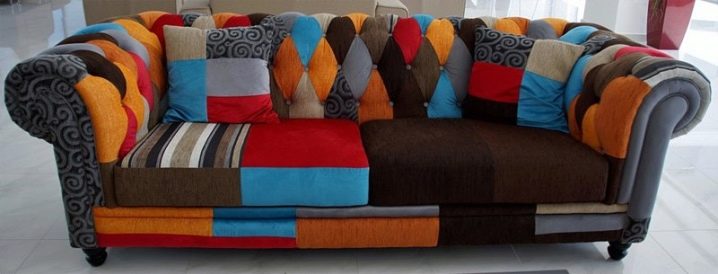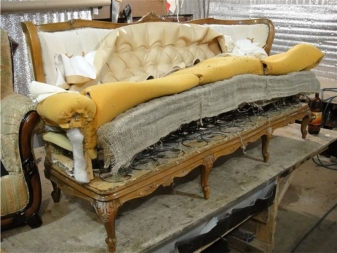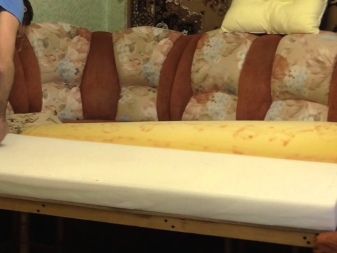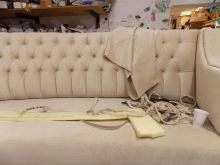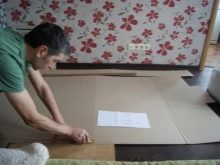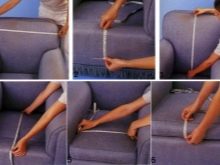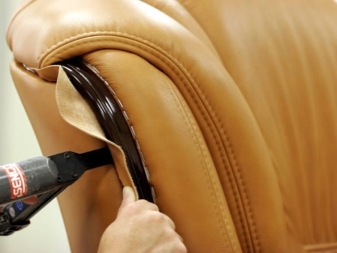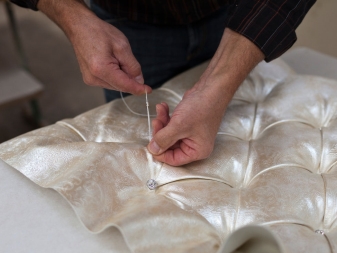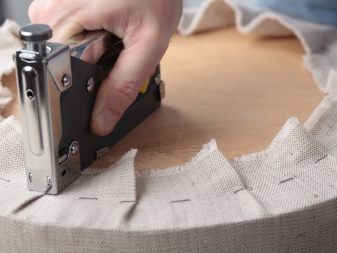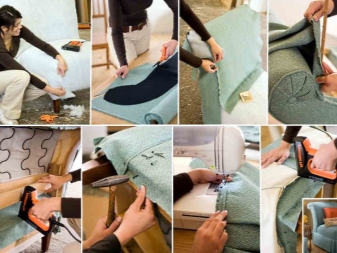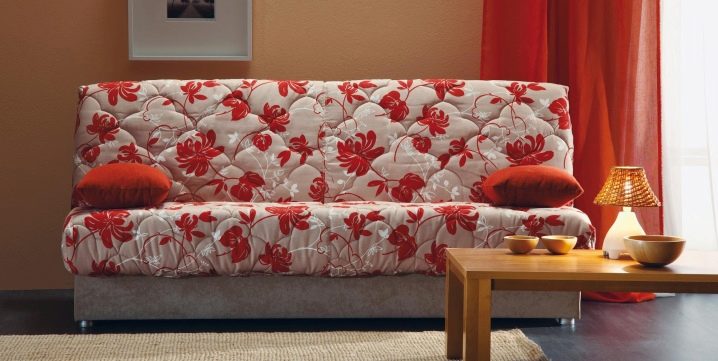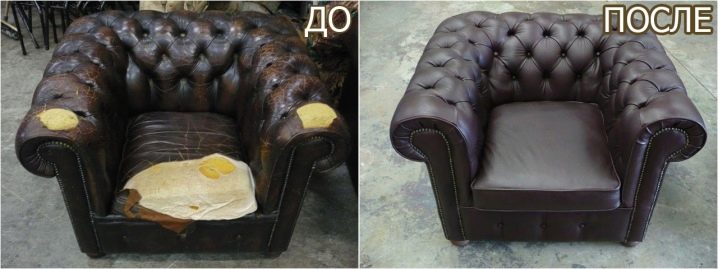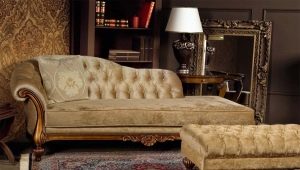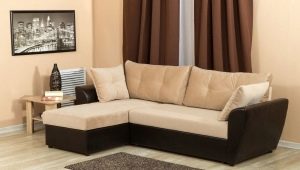Padding sofa
Sooner or later, but even the most high-quality and modern sofa can lose its former appeal. Every year of operation, the upholstery of this furniture becomes thinner, stains and bald spots can appear on it. Correct the situation will help the waist of the sofa, which, if necessary, can be done independently.
Special features
You can drag upholstery on the sofa of any shape and size, while this work can be done both independently and with the help of specialists in the furniture workshop. In the case of the implementation of the waist, it’s worth remembering that such a process has some peculiarities that you will definitely have to encounter during the work.
First of all, you will have to take care of the choice and purchase of not only the suitable material, but also its sufficient quantity. So, for a leather sofa, as an upholstery material, it is better to purchase not natural leather, but eco-leather, and the material should always be taken with a reserve.
Not only the appearance of the restored furniture, but also the subsequent term of its operation will depend on the right choice of fabric.
Be sure to take into account structural features of a particular model of furniture. Some sofas have a rather complicated shape and when replacing the upholstery they cannot be completely disassembled, so you have to try so that in such places the fabric completely repeats the shape of the sofa itself. So, dragging an angular sofa, it is necessary to pay special attention to the degree of stretching of the fabric on the corners and joints of the connection parts of the frame of this furniture. There may be some difficulties in doing this job without the proper skills.
The second feature is that if the furniture is too old and not only the upholstery fabric itself has worn out, it will be necessary to replace not only the material, but also partly the filler in the furniture, and possibly some parts of the frame.
This is worth taking care in advance.
Thanks to the constriction of sofas at home, you can not only extend the life of the furniture itself, but also visually benefit from changing its appearance, and with it the room itself.After all, many people know that the general style of the interior of the room is still set by the furniture that is located in it. Therefore, the approach to the process of restoration must be taken very seriously. During the work itself one should not rush and be distracted by foreign objects. It is best to engage in plating at a time when no one and nothing can disturb you.
In advance, you need to be prepared for the fact that the work itself, and especially for the first time, takes you quite a lot of time and effort.
By and large, any sofa can be sheathed at home, regardless of its dimensions. The main thing is to stock up in advance with all the necessary materials and tools carefully study the instructions for the implementation of this work and be ready to follow it completely. If such work seems to be quite laborious, then you can practice on a chair or chair, or even entrust the performance of upholstery to the specialists.
Material selection
In any case, regardless of whether the upholstering of the upholstery will be done independently or by specialists, the first thing you will have to face is the choice of a suitable material. Experienced craftsmen recommend using the following tips in this case:
- Sure to you need to change and soft filler sofa, and not just its upper fabric. If a synthetic winterizer acts as a filler, then preference should be given to the one that has a pure white color, since this is evidence of its high quality. If the filler is foam rubber, then it is necessary to use two of its sheets 2 cm thick each, and lay a sheet of felt between them.
- As the material of the upholstery is better to choose dense fabric having a small pattern without large and voluminous prints. This will save on the material, because it will not recline its pieces due to a mismatch of the pattern. In addition, as practice shows, such sofas get dirty less and in the process of operation they retain their appearance better.
- It is better to give preference to fabrics that do not have a nap, for example, from leatherette. If there are villi, it is necessary to ensure that they are short and of the same length. Pay attention that the fabric does not have a sharp and strong unpleasant synthetic flavor. If it is, then it indicates low quality and its unsuitability as a use of fabric for furniture restoration.
- It is better opt out of too coarse materials and replace them with eco-leather or tapestry, which will give the furniture a refined, beautiful and stylish appearance. The word “coarse” implies a fabric that is unpleasant to the touch and has a non-representative appearance. Using such material, you can not upgrade your furniture, but on the contrary, artificially wear it out even more.
- It is worth remembering that natural cotton materials crumple too fast and when using them during dragging, they lose their original appearance, so it’s best to give them up. Otherwise, after a few months of regular use of the sofa, he may again need restoration.
- Jacquard fabric fits perfectlyit is rather dense, wear-resistant, has an attractive appearance and at the same time is realized in various color variations. But it is better to give preference to jacquard of dark tones and without bright color accents on the fabric. They are the first to be erased and spoil the entire look of the upholstery.
- Flock and velor have beautiful appearance and quite pleasant to the touch, but at the same time quickly wipe and lose their attractiveness, so the use of such fabrics is also highly undesirable.
- Such material as chenille, has good wear-resistant performance, is attractive in appearance and perfectly cleaned of any contamination, so it is recommended to use it as a material for tugging sofas.
- Arpatek It may well be a worthy substitute for natural leather or eco-leather, as it has the same characteristics as they, but has less cost.
As the main material for tugging sofas, you should choose a dense fabric, without a nap with a fine pattern, or monochrome materials that have high wear resistance. Only such fabrics make sense to choose, because they will allow the use of an updated sofa for a very long time.
I would also like to note that if the sofa has wheels or legs, they should also be replaced with new ones during the upholstery upholstery. This will allow you to refresh the look of the sofa completely and improve its sustainability.
Preparatory stage
After the necessary material is selected, you can proceed to the first step of tugging the sofa, which is to create a pattern of fabric.This stage should be given special attention, because the result of the entire final work will depend on the quality of its implementation. In this case, the pattern can be made in two different ways:
- Make a pattern based on the old upholsterywhich was previously dismantled from the couch. In this case, the removed upholstery is applied to the acquired fabric and is circled around the contour. Be sure to leave an inlet of a few centimeters - 5 will be quite enough. In the future, the resulting pattern is applied to the furniture frame and if it matches its contours, it is cut.
- The second option is more time consuming. First, all the parts that can be removed - the armrests, backrests and pillows are removed from the sofa, are carefully measured with a tape measure from all sides, and the results are transferred to the fabric with the addition of 5 cm on each side. Further all parts of the pattern are cut and applied to the appropriate places of the sofa. If everything is in order and parts of the pattern have the required size, you can proceed to further action.
When creating a pattern using any of the methods described above, experts recommend double-checking the accuracy of the measurements made before cutting the pattern out of fabric.It is in this situation that the saying “measure seven times, cut once” is more relevant than ever.
Required tools
In order to perform the waist of the sofa at home, as well as to perform its preparatory stage - creating a pattern, The following tools may be required:
- Upholstery material itself.
- The filler material.
- Scissors.
- Chalk or bar of soap.
- Stapler and staples for it.
- Safety pins.
- A sewing machine or just a thread with needles.
- Especially strong threads.
- Screwdriver.
- Pliers.
- Passatizhi.
- Tape measure or ordinary measuring tape.
Depending on the type of sofa, you may still need a glue gun, medium thickness felt, a spring block, a screwdriver, and screws. The number of tools always depends on what kind of model, shape and dimensions of the sofa chosen for restoration.
If everything is clear with the material, scissors and chalk, then pliers and a screwdriver, as well as pliers, can be used to loosen some parts of the sofa by directly performing the material pulling. Not all cases may require the use of all the above tools,but just in case it is better to prepare everything in advance, rather than then run around the apartment in search of a suitable tool.
How to do it yourself?
Covering a sofa at home is not such a difficult process. If this procedure is performed for the first time, then of course there may be some difficulties. In order to avoid them and cover your own favorite sofa as simply and quickly as possible, we will step by step tell you how to pull two types of sofas - regular and angular.
Straight without springs
Work should begin with the dismantling of the individual components of the sofa, such as the corners, pouf, back and pillows:
- If necessary, use a screwdriver or pliers. The main thing, dismantle very carefullyso as not to damage all parts of the sofa. It is best to put them together consistently to the removal.
- Further the old upholstery is removed from the body of the sofa and removed parts. This process is quite time-consuming and requires utmost accuracy, because the removed material can later be used as the basis for the pattern. It must be spread out on a flat horizontal surface for leveling.This will help in the future to take measurements more accurately and correctly create a pattern.
- After removing the tissue clears the inside of the sofa, removes dust, debris and packing particles. Now, if necessary, you should remove the entire gasket and replace it with a new one, or simply fix it and give it the correct position.
- The next stage is create patterns. How correctly it can be done was described in detail above, so we will not describe this process again.
- Now it is necessary cut parts attach directly to the sofa. This work should be done in stages and carefully. The material itself must be stretched as evenly as possible so that the pattern does not squint and as a result the sofa has the appearance of a new one. It is best to start hauling from the back, sidewalls and seats of the sofa.
- After the upholstery is replaced by them, you can proceed to direct retightening of the frame the sofa itself. The fabric is attached with needles and thread on the removable parts and with the help of a stapler on the frame. You can use a standard glue gun.
- Now it is necessary reassemble the sofa in the reverse order of its dismantling. In that case, if there are pieces of fabric, they can be used for constriction ottomans or decorative decoration of the backs or armrests of the sofa itself. The decor, of course, should be chosen independently, in accordance with the general interior of the room and the style of the furniture itself.
Corner with spring mechanism
The corner sofa itself has a more complex structure, and the level of complexity of the upcoming work on the replacement of the upholstery also increases the available springs. Therefore, I immediately want to say that the plating of the spring sofa will be more lengthy and troublesome compared to the restoration of a simple model that does not have spring blocks. In any case, the process of tugging the sofa itself can be divided into the following steps:
- Disassembling the sofa into two components. Here it is necessary to separate the corner pieces from each other. With proper implementation of this stage, you should have a detached small sofa and a corner chair.
- Now you need to remove all parts that can be dismantled independently.
- Then we remove all the stuffing from them and also act with the material on the frame of the sofa itself.
- We take out the filler and take out the spring block itself, which is attached to the bottom of the sofa with the help of twine, which must be carefully cut. If the springs are whole, then gently straighten them and put them in place, if not, then go to the hardware or furniture store and get new ones.
- It is necessary to bind together all the springs with very durable linen or cotton threads.
- We make a pattern from the removed stuffing, and we gently fold it and place it over the springs, lay the filler on top, new or previously cleaned of existing dirt.
- Now we cut out the obtained patterns and sheathe the new upholstery, first the removable parts of the sofa, then its frame. As in the previous case, you should carefully monitor the uniform tension of the material on the parts of the sofa.
- After all parts of the furniture are re-tightened, you first need to assemble the sofa, that is, to join the sofa itself and the corner chair, and only then install its removable parts.
In a similar scheme, you can restore almost any model of sofas with spring blocks. The main thing is to follow the instructions carefully and carry out all stages of work without haste.
Tips masters
Speaking of self-reattachment of sofas at home, one can not but say about the useful advice of experienced professionals in this matter. It is their recommendations that will help perform such work as correctly, safely and quickly, but the most important thing is that the result will please you for a very long time.
First of all, it is worth mentioning once again about the choice of the material for the waist of the sofas, it should be not only dense, but also quite heavy. The fact is that such furniture is used in various situations, and the heavier the fabric, the longer it will last for you. The material is exactly the part that is not worth saving.
Often, when performing such work, many people prefer to change the upholstery inside the furniture itself. This makes sense if the inner packing is in a satisfactory condition. If it has completely fallen into disrepair, and the spring unit, if present, also has to be changed, it is better to abandon the restoration of such furniture and purchase a new one. Many competent furniture specialists often say that the complete restoration of a sofa is often more expensive than buying a new one.Therefore, it is possible to re-tighten the sofa if its springs or gaskets are in normal condition.
If such works are performed for the first time, you should first practice on smaller furniture. If the sofa is expensive or antique, it is better to give it to specialists for restoration.
Tugging sofas is actually quite an exciting and creative exercise. Many people admit that having completed the restoration of their furniture on their own, they began to practice such works regularly. After all, such upholstering of the upholstery allows you to change the appearance of the furniture when you want, and with constant practice, restoration takes little time and does not cause any inconvenience.
How to give a second life to the old sofa, see the following video.
